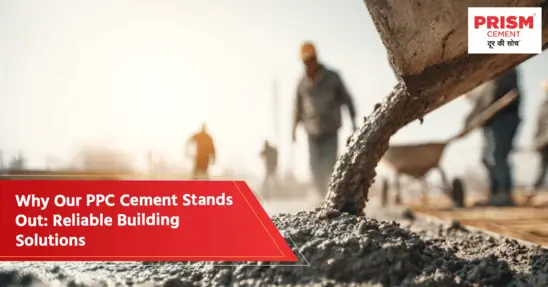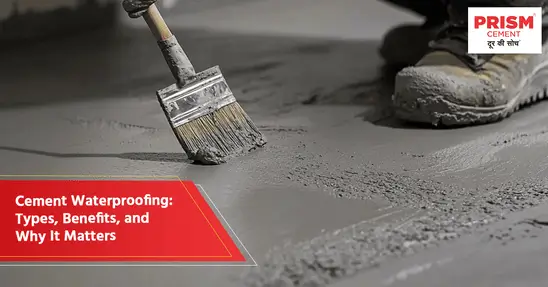Wall cracks are a prevalent problem in residential and office buildings, and they usually create distress among homeowners and property managers. Choosing the right material for repairing wall cracks is essential to have a long-lasting and durable solution. This blog discusses why PPC cement is the best choice for repairing cracks in walls.
Understanding Wall Cracks
Wall cracks can occur because of several factors, ranging from structural settling to temperature change, moisture infiltration and unsatisfactory building construction. Besides undermining the building's aesthetic appearance, such cracks also present future structural hazards when not addressed. Identification of the type of crack is the first step before repairs.
What is PPC Cement?
PPC cement, or Portland Pozzolana Cement, is a blended cement that results from grinding Portland cement clinker with pozzolanic materials such as fly ash or calcined clay. This provides PPC cement with specific features that make it extremely ideal for use in construction activities, such as wall crack repair.
Why PPC Cement is Ideal for Repairing Wall Cracks
- Improved Durability: The pozzolanic reaction in PPC cement results in a denser and less permeable concrete structure. This characteristic has a substantial bearing on the durability of the repaired section, which becomes resistant to moisture and chemical attacks.
- Lower Heat of Hydration: PPC cement produces less heat upon hydration than Ordinary Portland Cement (OPC), which minimizes the chances of shrinkage and thermal stresses developing in the repaired section. This is particularly beneficial when repairing existing wall cracks, as it promotes better adhesion, reduces the likelihood of further cracking, and enhances the longevity of the repair.
- Enhanced Workability: PPC cement is more workable, easier to apply and capable of filling very fine cracks effectively. This is extremely useful for the control of cement plastering ratio and producing a smooth surface finish.
- Increased Strength in the Long Term: The pozzolanic reaction goes on increasing the strength of the repaired area gradually over time. This provides durability and stability of the repair.
- Resistant to Cracking: Finer particle size of PPC cement results in a more cohesive mixture, less likely to shrink or crack. It is necessary to avoid the growth of future cracks in the patched areas.
- Ideal for Plastering: PPC cement can be said to be the best cement for plastering because of its fine texture and workability that helps in achieving a smooth even finish on cement walls.
- Flexibility: PPC cement can be applied for all types of work, such as cement screed and screed flooring, so is a versatile solution for complete building repairs. The application of Portland pozzolana cement covers many aspects of construction business.
Step-by-Step Tutorial on PPC Cement Application in Cracks on the Wall
- Preparation: Clear out the crack by eradicating all loose rubbish and old plaster.
- Mixing: Prepare a paste of PPC cement with the right water-cement ratio, making it smooth and uniform.
- Application: Fill the crack with PPC cement paste using a trowel or putty knife, filling it completely.
- Smoothing: Smooth the repaired area to blend with the surrounding wall, giving a smooth finish.
- Curing: Allow the repaired area to cure properly, keeping it moist for several days to enhance strength development.
Additional Tips for Preventing Future Wall Cracks
- Ensure proper foundation design and construction.
- Maintain consistent moisture levels around the building.
- Use proper construction materials and techniques.
- Regularly inspect walls for any signs of cracking.
Conclusion
PPC cement is the best option to use for the repair of cracks in walls due to its added durability, better workability and resistance to cracking. It is possible for homeowners to successfully repair wall cracks and ensure their structures' long-term stability if they follow proper procedures and preventatives. Prism Champion All Weather Cement is an ideal option for long lasting beauty of your walls, preventing cracks, seepages and leakages.
FAQs
Q1. How does PPC Cement help in repairing wall cracks?
Answer: PPC cement gives a hard and solid repair because of its pozzolanic reaction, which decreases permeability and improves long-term strength.
Q2. Why is PPC Cement superior to OPC for repairs in wall cracks?
Answer: PPC cement produces lower heat of hydration, decreasing thermal cracking risk and provides better workability, enabling easy filling of cracks.
Q3. Is PPC Cement suitable for repairs in both interior and exterior walls' crack repair?
Answer: Yes, PPC cement can be applied both internally and externally for wall crack repair because of its strength and weather resistance.
Q4. What is the right mixing ratio of PPC Cement for filling cracks?
Answer: The right mixing ratio varies depending on the application, but a typical ratio is 1:3 (cement: sand) for plastering and a paste-like thickness for filling tiny cracks. The cement plastering ratio will depend on the requirement.
Q5. Does PPC Cement enhance the durability of restored walls?
Answer: Yes, PPC cement greatly enhances the durability of restored walls through the formation of a denser and less porous concrete matrix.




